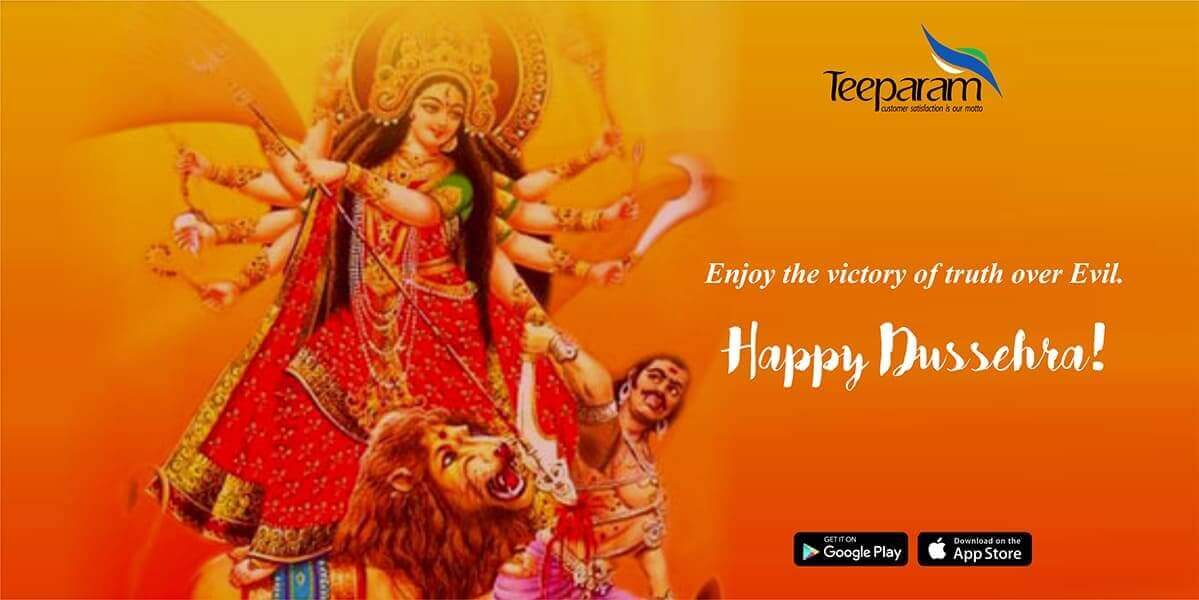
Why Celebrate Vijayadashami?
The History of Celebrating Vijayadashami
India is a nation of diverse traditions. We Indians celebrate a lot of festivals and one among them is Vijayadashami. It is one of the most significant festivals in the cultural tradition of India.
Reason Behind the Celebration of Vijayadashami
Though Dussehra is known by different names in different states across India, the basic essence of celebrating this festival remains the same - the Dharma (good) prevailing over Adharma (evil). Vijayadashami is one of the significant festivals in the cultural tradition of India. The Dashami Tithi or the tenth day of Navaratri marks the triumph of the good over the evil and is considered as an auspicious occasion to start any new venture.
Vijayadashami celebrates Maa Durga's victory over demon Mahishasura to protect Dharma. This day marks the victory of divine power over demoniac forces.
The day also marks the History where Lord Rama killed the ten-headed Ravana, who had abducted Rama's wife Sitadevi. People burn the effigies of Ravana to celebrate the victory of righteousness over evil. These effigies are burnt down with the help of fireworks thus reminding the onlookers that no matter what happens, Dharma always wins over Adharma.
Some Interesting Facts About Vijayadashami
Everyone knows the auspiciousness and the reason behind the celebration of Vijayadashami. How about exploring some interesting facts about this auspicious day? Read further…
- Vijayadashami means the Day of Victory
- Marks the end of nine-day long Navaratri celebrations
- Celebration of Goddess or Feminine Divinity
-
Marks the day of Victory
- Marks the triumph of Goddess Durga over the Demon Mahishashura
- Marks the victory of Lord Rama over Demon Ravana
- In Nepal, Dussehra is celebrated as Dashain
- An ideal day to start any new venture
- Believed to achieve success in life by conquering all three qualities
- Parents admit their kids to school on this day - the auspicious beginning for the schooling
Significance of Dussehra and Vijayadashami
The 9 days preceding Vijayadashami are celebrated as Navaratri, where Goddess Shakti or Durga is worshipped in 9 different forms, namely:
- Shailaputri - represents Parvati in her stage of childhood
- Brahmacharini - represents Parvati in her phase of asceticism
- Chandraghanta - represents Parvati in her married aspect
- Kushmanda - represents Devi Parvati in her stage of discovering that she is none other than the supreme power Mahashakti
- Skandamata - represents Devi Parvati in her stage of motherhood
- Katyayani - represents Parvati in her warrior stage
- Kaalratri - represents Parvati in her phase of destruction
- Mahagauri - represents Parvati in her phase of recovery
- Siddhidhatri - represents Devi Parvati in her stage of reaching her highest and supreme form, knowing who she is, the complete manifestation of Goddess Mahashakti
Vijayadashami and Southern India
Vijayadashami is celebrated in various forms in South India. The celebrations range from worshipping Durga, lighting up temples and major forts - such as at Mysore, to displaying colourful figurines arranged neatly as a Golu
In South India, especially in Tamil Nadu, Karnataka, Telangana, and Andhra Pradesh, the Navaratri is celebrated with a display of Golu, a display of dolls and figurines depicting various events in Puranas. It also includes dolls of various other celebrations such as royal processions, weddings, and other grand events. Women celebrate these 9 days by inviting each other to visit their homes to see the Golu display and participate in bhajans.
About Teeparam
With Teeparam Exchange, send your money to Sri Lanka and India easily. We
offer safe, secure, and reliable same-day money transfer services. Our services
are offered at the best competitive pricing in the market. Be it sending money to
Colombo or Croydon, our professionals will guide you in the right way. To
know more, check out
@ Teeparam Exchange Limited